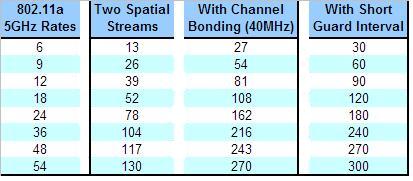Reaching the maximum performance for your 802.11n device requires several key features to be implemented.
First make sure you have a wireless router that fully supports 802.11n.
What does this mean?
802.11n includes support for channel bonding. It's possible to implement channel bonding in 2.4 GHz, but it is not as effective as 5 GHz. The 2.4 GHz band has three channels. Bonding two of them together affects nearby wireless routers using this band. You can only have a single bonded channel in 2.4 GHz. It's also possible that nearby wireless routers using one of the bonded channels will cause interference on the 802.11n network, reducing performance.
In the 5 GHz band, there are many more channels available. Having several wireless routers in the same location is the optimal solution to reach the maximum 802.11n speeds.
Antennas are another key element to improving 802.11n performance. More antennas generally improve performance. Currently most devices have either two or three antennas.
Another important element is the full support for IEEE features. Improved MAC features of short guard interval, packet aggregation, and reduced interframe spacing (RIFS) greatly improve the efficiency of the MAC layer.
The table below shows that two spatial streams with channel bonding in the 5 GHz band and support for the IEEE short guard interval gives the best performance.
Check with your wireless router manufacturer to see if your router supports all of these features.
